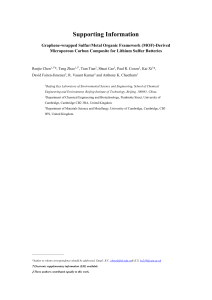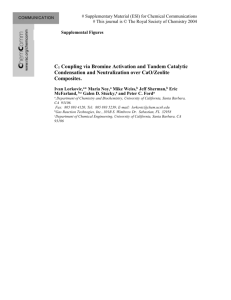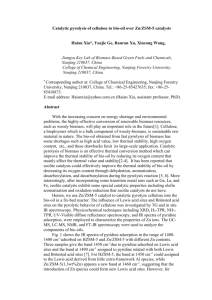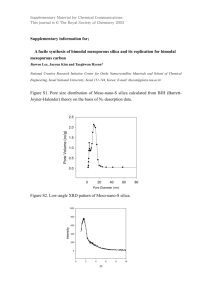1 Catalyst can be defined as ... undergoes no net chemical changes ...
advertisement
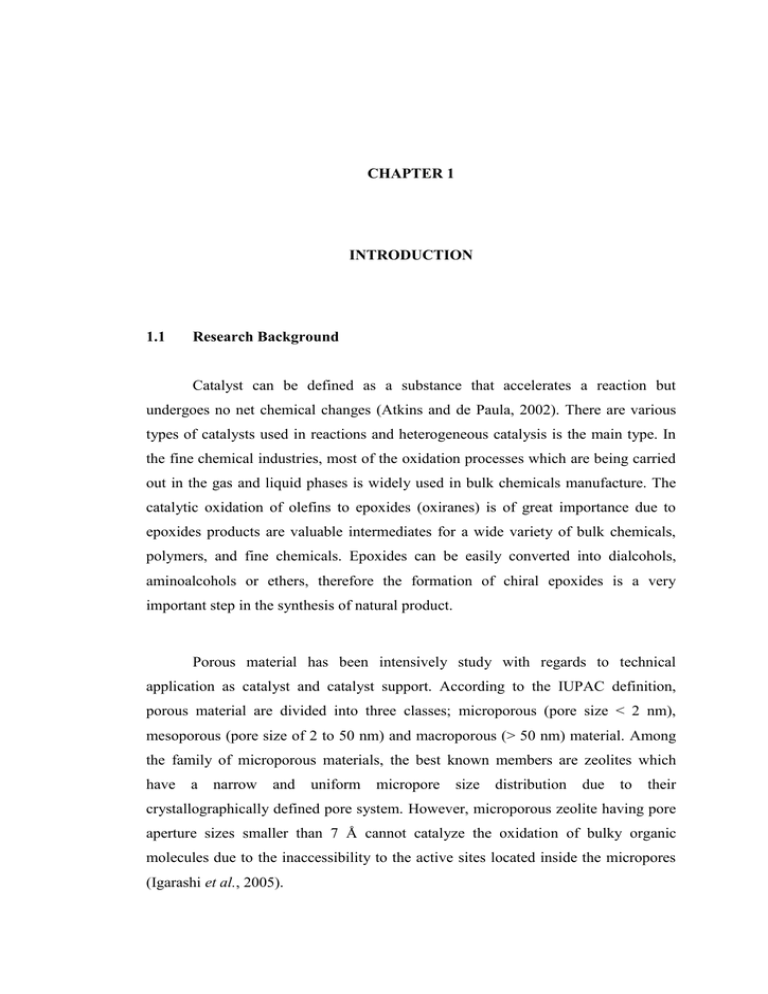
1 CHAPTER 1 INTRODUCTION 1.1 Research Background Catalyst can be defined as a substance that accelerates a reaction but undergoes no net chemical changes (Atkins and de Paula, 2002). There are various types of catalysts used in reactions and heterogeneous catalysis is the main type. In the fine chemical industries, most of the oxidation processes which are being carried out in the gas and liquid phases is widely used in bulk chemicals manufacture. The catalytic oxidation of olefins to epoxides (oxiranes) is of great importance due to epoxides products are valuable intermediates for a wide variety of bulk chemicals, polymers, and fine chemicals. Epoxides can be easily converted into dialcohols, aminoalcohols or ethers, therefore the formation of chiral epoxides is a very important step in the synthesis of natural product. Porous material has been intensively study with regards to technical application as catalyst and catalyst support. According to the IUPAC definition, porous material are divided into three classes; microporous (pore size < 2 nm), mesoporous (pore size of 2 to 50 nm) and macroporous (> 50 nm) material. Among the family of microporous materials, the best known members are zeolites which have a narrow and uniform micropore size distribution due to their crystallographically defined pore system. However, microporous zeolite having pore aperture sizes smaller than 7 Å cannot catalyze the oxidation of bulky organic molecules due to the inaccessibility to the active sites located inside the micropores (Igarashi et al., 2005). 2 ZSM-5 zeolite, which was first developed in 1972 by Mobil, has a regular channel system, i.e. straight circular channels (5.4 Ǻ-5.6 Ǻ) interconnecting with sinusoidal and elliptical channels (5.1 Ǻ-5.4 Ǻ) (Wang et al., 2007). The properties that make ZSM-5 suitable for industrial applications are its extremely high thermal and acidity stability, high selectivity, and high activity in certain catalytic conversion especially in the case of shape-selective catalyst (Wang et al., 2007). Unfortunately, zeolites present severe limitations when large reactant molecules are involved, especially in liquid-phase systems as is frequently the case in the synthesis of fine chemicals, due to the fact that mass transfer limitations are very severe for microporous solids. Attempts to improve the diffusion of reactants to the catalytic sites have so far focused on increasing the zeolite pore sizes, on decreasing zeolite crystal size, or on providing an additional mesopore system within the microporous crystals. Researches on mesoporous silicas and related materials are important fields of recent material science. Especially MCM-41and its analogues are actively studied because of their high potentials for various applications. The inventions of mesoporous material by Kresge et al. (1992), Kuroda (1996), and Inagaki et al. (2004) belonging to Mobil, Waseda and Toyota research groups, respectively have lead to the intensive studies for developing highly active catalytic materials. MCM41, which is a member of mesoporous molecular sieves family have been recently discovered by researcher at Mobil Corporation (Chen et al., 1999). MCM-41 stands for Mobile Composition of Matter No. 41 possessed highly ordered hexagonal array of unidimensional pore with very narrow pore size distribution. The narrow pore size distribution adjustable in the 15-100 Ǻ range and an extremely high surface area makes these materials promising candidates as catalysts or catalyst supports, absorbent and as a host. The main disadvantage of MCM-41 is that its wall is amorphous, thereby leading to its lower mechanical, thermal and hydrothermal stability (Chen et al., 2009). Apart from that, MCM-41 also does not exhibit comparable catalytic properties to those of microporous silicate such as ZSM-5 and zeolite Y which have abundant, uniform micropores structures and strong acidities which lead them to 3 possess crystalline structures and higher stability. Unfortunately, the microporous silicates are not appropriate for effectively reacting with large molecules because of the limitation of their small pore size. Recently, the composite materials have been a significant concern as to developing materials with unique properties. Composite material or composite is defined as engineered material made from two or more constitual materials with significantly different physical and chemical properties which remains separate and distinct on a macroscopic level within the finished structure. There are many studies had been done in developing composite materials which includes the usage of mesoporous and microporous materials. Basically, the meso-microporous materials provide bimodal pore systems and combine the benefits of each pore size regime which could potentially improve the efficiency of zeolite catalysis. Thus, great interest has been generated in the synthesis of bimodal composite materials to combine the performances of both mesoporous and microporous molecular sieves. Jacobsen et al., (2000), have reported the usage of mesoporous carbon blacks as templates to prepare nanosized zeolites, which possess micromesoporous properties by using one-step crystallization. Kloetstra et al., (1996), on the other hand has reported the preparation of zeolite faujasite coated with a thin layer of mesoporous MCM-41 prepared by a one step synthesis. Huang et al., (2000), reported the preparation of ZSM-5/MCM-41composites by using a dual template method through a process of a two-step crystallization. Guo et al., (2001), synthesized a series of Beta/MCM-4l composites with various crystallinities through a two-step crystallization process. Basically, an alkene can be oxidized to an epoxide by a peroxyacid (Bruice, 2004). The epoxidation of an alkene is a concerted reaction, where all the bondforming and bond-breaking process takes place in a single step. The setback of homogeneous epoxidation of alkene reaction is the usage of expensive peracids as oxidants apart of the formation of large amount of effluent (Blasco et al., 1995). In order to overcome this problem, this study is focused on the catalytic performance of 4 Al-MCM-41/ZSM-5 composite as a heterogeneous catalyst in the epoxidation reaction by using hydrogen peroxide as an oxidant. MCM-41 is a member of a family of mesoporous molecular sieves that had been discovered by researcher at Mobil Corporation (Chen et al., 1999). Purely siliceous MCM-41 is amorphous and has no Bronsted acidity. The isomorphous substitution of Si by trivalent cation such as Al by the isomorpous substitution of the aluminium for silicon atoms during hydrothermal synthesis or secondary synthesis creates moderately acidic sites (Zanjanchi and Asgari, 2004). The synthesis of AlMCM-41 by a direct method exhibits low hydrothermal stability especially at relatively low Al-content. (Adjdir et al.,2009a). However, Al-containing MCM-41 has relatively low acidity as compared to that of the zeolite ZSM-5. Therefore, the improvement on the acidity of this mesoporous material is required. Zeolite, especially the ZSM-5 zeolite is very much of interest due to its high acid strength, pore shape, selectivity and also stability. The number and the strength of acid sites dictated by distribution of aluminum ions in ZSM-5 crystal lattice are responsible for its catalytic activity towards various reactions (Sahoo et al., 2001). The main inconvenient of ZSM-5 for many applications is its micropore size which limit the accessibility to substrates of small kinetic diameter which is smaller than 7 Ǻ (Trong et al., 2003). Green technology or the use of environmental friendly chemical process is now gaining popularity because of the demand from consumer as well as strict environmental regulation. Thererfore, application of the heterogeneous catalyst is very wide nowadays as compared to the application of the homogeneous catalyst. In view of the pore size limitations of microporous zeolites and low acidity mesoporous silica materials, it is of interest to prepare a composite catalyst that would combine the Bronsted acidity of crystalline zeolite with the regular pore size of amorphous mesoporous material. In present study, mesoporous Al-MCM-41 material is composite with ZSM-5 in order to enhance the acidity, thermal stability as well as catalytic property of MCM-41 in the oxidation of norbornene. For industrial application, zeolites are known as promising component in heterogeneous acid 5 catalyst. The mass transfer to the active site of zeolite inside the micropores is quite important to industrial aspect. However, the efficiency of zeolite is limited because of its microporosity, leading to the deficiency in diffusion limitation throughout the crystal, resulting in saturation of catalyst efficiency and performance (Ogura et al., 2007). Apart from that, Al-MCM-41 also have setback which is due to its amorphous character which result in comparison with microporous zeolite in lower acidity and hydrothermal stability. Therefore, the application of this type of mesoporous aluminosilicate as acid catalyst for processing of bulky compounds is limited (GonÇalves et al., 2008). To overcome this limitations, the study is being carried out to combine mesoporosity of the mesoporous aluminosilicate with the acidity and stability of microporous zeolite. In the present study, the Al-MCM-41 and Al-MCM-41/ZSM-5 composite is being synthesized. This is because the incorporation between both AlMCM-41 and ZSM-5 may be a good attempt as to improve the diffusion of reaction to the catalytic site of zeolite by providing additional mesopores system within the microporous crystal, allowing larger molecules to enter the pore system, to be prossed there and to leave the pore system again (Taguchi and Schuth, 2005). This improvement of chemical and physical properties of the material makes Al-MCM41/ZSM-5 composite a better catalyst as compared to Al-MCM-41 or ZSM-5 alone. The comparison between both microporous/mesoporous composite with incorporation of different weight percentage of ZSM-5 catalyst is very important to distinguish which is a better catalyst toward oxidation of bulky norbornene, known as bicyclo [2.2.1] hept-2-ene to norbornene oxide. 1.2 Objective of Study The objectives of this study are: i. To synthesize mesoporous Al-MCM-41 directly by hydrothermal method with initial molar composition of 6 SiO2 : CTABr : 1.5 NaO : 0.15 (NH4)2O : 250 H2O with Si/Al = 30. 6 ii. To synthesize Al-MCM-41/ZSM-5 composite with different ratio of ZSM-5 weight percentage by using direct synthesis through two step recrystallization process. iii. To characterize the physicochemical properties of the synthesized Al-MCM41 and Al-MCM-41/ZSM-5 composites. iv. To determine the catalytic performance of Al-MCM-41/ZSM-5 composite with different wt. % of ZSM-5 in the oxidation of bulky molecule norbornene to norbornene oxide with hydrogen peroxide as oxidant. 1.3 Scope of Study The conceptual framework of the study is shown in Figure 1.1. This research is carried out to synthesize mesoporous Al-MCM-41 with the sol-gel method with initial molar composition of 6 SiO2: CTABr: 1.5 NaO: 0.15 (NH4)2O: 250 H2O with Si/Al = 30. The silica source used in synthesizing the Al-MCM-41 is rice husk ash with SiO2 content of 93%. The synthesis of Al-MCM-41/ZSM-5 composite is done by using the same method as in the preparation of the Al-MCM-41 but with addition of microporous ZSM-5 zeolite. In the study, the commercial ZSM-5 zeolites were added in two different ratios of weight percentage which are 10 wt.% and 50 wt.% respectively. The BET single point method is used to determine the surface area of AlMCM-41, Al-MCM-41/ZSM-5 composite. 10 wt.% and also Al-MCM-41/ZSM-5 composite 50 wt.%. The Nitrogen Adsorption and desorption Isotherm is used to determine the specific surface area as well as to monitor and determine the porosity or the pore texture of the Al-MCM-41/ZSM-5 composite. The structure characterization of the sample is characterized by using Fourier Transform Infrared Spectroscopy (FTIR) and X-Ray Diffraction Spectroscopy (XRD). The Field Emission Scanning Electron Microscopy (FESEM) is being used to determine the surface morphology of the produced Al-MCM-41 and Al-MCM- 7 41/ZSM-5 composite as well as the commercial ZSM-5. Transmission Electron Microscopy (TEM) on the other hand is being employed to analyze the pore shape and pore size of Al-MCM-41/ZSM-5 composite. The thermal stability of Al-MCM41 and Al-MCM-41/ZSM-5 composite is determined by using Thermogravimetric Analysis (TGA). Lastly, the 27 Al MAS NMR is used to characterize the nature of aluminum species (tetrahedral or octahedral) in the composite. Both catalysts (Al-MCM-41/ZSM-5 composites with different wt.% of ZSM5) performances are tested in the oxidation of bulky norbornene with hydrogen peroxide (H2O2) as oxidant. The reaction was carried out in a batch reactor and the products obtained were analyzed by gas chromatography (GC). The products obtained from oxidation reaction were analyzed qualitatively by GC-MS and quantitatively by GC-FID equipped with a HP-5 column. 8 The synthesis of Al-MCM-41 and Al-MCM-41/ ZSM-5 composite Characterization of each AlMCM-41 and Al-MCM-41/ ZSM-5 composite produce by using FTIR, BET single point and XRD. Characterization of produced Al-MCM-41 and Al-MCM-41/ ZSM-5 composite with difference wt.% of ZSM-5 added Characterization of the size and morphology of Al-MCM-41, ZSM-5 and Al-MCM-41/ZSM5 complex by using FESEM and TEM Characterization of AlMCM-41/ZSM-5 composite of different wt.% of ZSM-5 added with 27Al MAS NMR Characterization of the surface area and pore size of Al-MCM-41/ZSM-5 composite using the Nitrogen AdsorptionDesorption Isotherm Analysis Figure 1.1: Conceptual Framework Catalytic activity of H-Al-MCM-41/ ZSM-5 composite Determination of catalytic activity of the composites in the oxidation of bulky molecule norbornene to norbornene oxide with hydrogen peroxide as oxidant. The product of the reaction was analyzed using GC-FID and GC-MS
